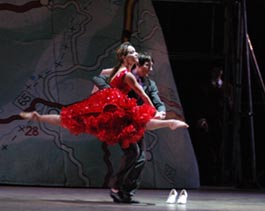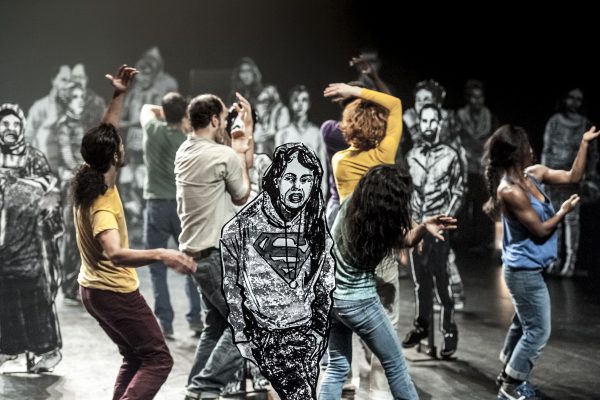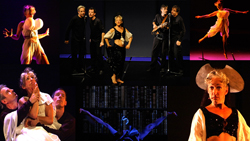Lin Snelling and her assembled troupe did a fine job of imagining the Belgo building in “Full Time at the Belgo” (“FTATB”). The stage for the innovative site-specific dance project was the vast, six-storey fixture itself, located at Saint Catherine Street West and Bleury. Dancers explored the architecture of the building and their bodies, and the public was invited along for the ride. Under the direction of this articulate dancer and choreographer, the creative team of artists — Alexia Bhéreur-Lagounaris, Katie Ewald, Nadine Sures, Sarah Wendt, Snelling herself, architect Stephanie Davidson and musician-composer Michael Reinhart — filled the warrens, staircases, washrooms and entrances of the former manufacturing mecca, capturing the flow and movement in the building.
For those unfamiliar with the Montréal artspace, the Belgo, as it’s more commonly called, has been a hub of artistic invention from the early 1980s. Now, dancers and visual artists jockey for studio space alongside gyms and yoga studios. In decades prior, the Belgo was a bustling home to the cutters and designers of the rag trade (you can still find sewing needles between the floor boards in some of the studios and galleries). Davidson, as someone who’s interested in the interaction between bodies and architectural surfaces, calls the Belgo “an accommodating, receptive space, very open and casual”.
The performers in “FTATB” used the location in many ways. A civic intervention, the Belgo project also served as a bit of history (you could hear the astute and glorious mover Jo Lechay — a former Belgo tenant and founder of the studio which is currently Studio 303 — reminiscing about Belgo lore on tape, and telling tales sprinkled with the names of members of the Montréal dance community).
Studio 303 produced “FTATB” and was a perfect partner for this kind of conspicuous (and inconspicuous) performance and interaction. The organization is known as a dance space and is recognized as an arts centre that offers cutting-edge workshops, internships and residencies, while also programming a multitude of events that stimulate exchange between artists, art forms and the public.
Snelling carefully laid out the groundwork weeks in advance, approaching all the tenants in the building and informing them of the upcoming event. Significantly, “FTATB” took place on one of the Journées de la culture, a provincially sponsored event geared to encourage and invest in the public’s appreciation and involvement in the arts. To that end, galleries, museums, dance studios, practice halls, etc., open their doors and welcome audiences into their spaces AND processes. This annual fall event is smart marketing and a favourite with the public — and with cultural activities offered for free, who wouldn’t at least be curious?
The production efficiently probed the pertinent question of how we meet. The group held public rehearsals two days prior to the main event, and the in-situ performance occurred on Saturday, October 1st, from 10am-5pm. It included an hour-long lunchtime discussion with the artists about what they’d done, along with a five-minute choreographed “how to be at a party” segment, where the public was invited to be part of a party. I should point out that I could not be present at the actual event on the Saturday, but I attended the open rehearsals a couple of days prior to the showing. I could gauge how the artists explored the boundaries of dance and architecture, and specifically how the dancers responded to different spaces, and how the body-scale elements played in the audience’s perception.
As the hours progressed, the dancers engaged in a free process of working and thinking. One of Snelling’s intentions was to shift our perception of what constitutes a dance event. The work was performative, but it would never have been the same without the participation of the audience, and certainly the action took place far from what could be considered a stage.
“FTATB” was divided into parts — with events in certain sectors of the building at different times throughout the day, but no event ever overlapping with another. (One visitor did comment that the lags between activities seemed long.) The public was offered a map of the building as they entered, so that they could navigate freely through the entirety of the space. Each floor of the Belgo feels fundamentally different: the fifth floor is filled with smart, visual arts galleries, while other floors seem less rarified, with the first floor still having the manufacturing feel, with scaffolding erected.
An e-mail correspondence that Snelling sent me prior to the event included a small text of different definitions of choreography written by writer and director Jeffrey Gormly and Michael Klien, artistic director of Daghdha Dance Company and a past artistic advisor to William Forsythe:
choreography (v) bodies in time and space
choreograph (v) act of arranging relations between bodies in time
and space
choreography (v) act of framing relations between bodies … “a
way of seeing the world”
choreography (n) result of any of these actions
choreography (n ) a dynamic constellation of any kind, consciously
created or not, self-organizing or super-imposed.
choreography (n) order observed…exchange of forces… a
process…that has an observable or observed embodied order
choreograph (v) act of witnessing such an order
choreography (v) act of interfering with or negotiating such an
order.
“FTATB” was, at various intervals, all of the above.
In a wonderful ten-minute segment, that Snelling dubbed “walking toward dancing”, the public first watched silently, and then slowly walked towards and then past the dancers down a long corridor with a wooden-slatted floor. The dancers’ syncopated movements — jumping, walking, and doing a headstand — were done within a confined space. Ideas of perspective, boundary and legibility danced in my head.
Moving to a different floor, we watched as the artists ran down the hall, their laughter and feet padding on the floor, echoing off the walls, their bodies becoming smaller and their laughter fainter and less percussive, while in the distance, guitarist Robert Fripp’s music echoed.
Throughout the performance, people in the building went about their daily business. All these bodies intersected with the dancing event. The sound of cellphones ringing, the clicking of high-heels and the boom-boom rumbles coming from the gyms made for a particularly vivid soundscape.
There were a couple of particularly incisive moments that happened spontaneously: a guy popped his head out of his office and told his co-worker that there were people “doing a theatrical mime-type thing in the hallway”. Then he asked, “Where are they from? The school?”
At another location, on a side marble staircase with metal railings, a couple of homeless people entered as another event took place. It was a particularly blustery and frigid day, and the wind was whistling and echoing in the chamber. The couple installed themselves to drink their coffee in calm and quiet on the steps of the passageway. Then, they took notice of the artists, who were speaking softly, hugging the railing leading along the stairs. The man and woman very quietly picked up their belongings and shifted to a floor below, seeming not to want to intrude. They watched the proceedings with bemused smiles, and eventually they left the staircase altogether.
Working in the staircase provided possibilities to reconsider the parameter of proximity, and left room and opportunity for audiences to look up and down the stairwell, while the performers moved up and down the steps.
In another memorable intervention, Snelling worked with an old sign from the Comfort Pants garment manufacturer within a square space. She started speaking a riff on the word comfort: “cold comfort”, “crisp comfort”, “creature comfort” and a general questioning of the impact of comfort. Then she asked her collaborators to direct her as she manipulated the sign. Snelling grasped onto an archway as she struggled with the sign. Then one of the artists suggested that she become the sign, and she responded by using the sign as her face, answering questions in a clever and immediate manner: “What do you do for a living? I hang. I have nowhere to go.”
All of the “FTATB” events reminded me, in a fashion, of Jerzy Grotowski’s “poor theatre”, a stripping away of all preconceived notions of theatre so that, without the costuming, props and artifice of the “rich theatre”, the “poor theatre” actor uses his own instrument to tear down the fourth wall between audience and performer, and thereby reveal both, more viscerally, to themselves.
To encapsulate the “FTATB” experience, it embodies a “you are there” technique: we arrived at the Belgo and this is what we saw and did. What the material means to the performers — for instance, why the beautiful old relic of a sign for the Comfort Pants manufacturers was employed, or why the artists in the stairwell used tin cans to communicate — is somewhat secondary.
Both in the playing and in the watching, the creative work seemed friendly, fragile and innocent. Snelling and her collaborators’ investigation, at least in the viewing I had, were never smug and self-serving. An intelligent beauty was in evidence, respecting the awkward balancing of questions about where we place ourselves in terms of participation and attraction. Tremendously pleasing in the venture was the dedication of the performers and their sense of play. Poor theatre? Perhaps in economic terms, but there’s inherent richness in the courage displayed and a definite love for investigating ideas about craft.
Tagged: Contemporary, Performance, Site-Specific, Montréal , QC





